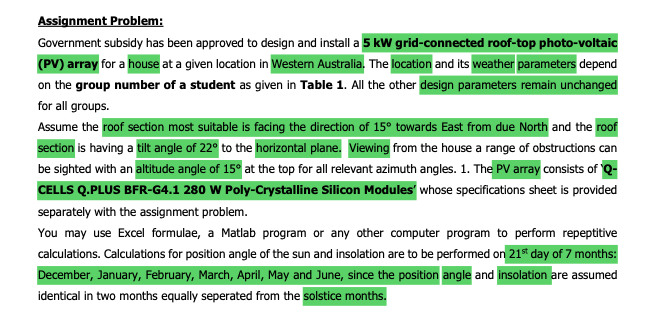Answered step by step
Verified Expert Solution
Question
1 Approved Answer
Please use highlighted values on table which are the ones with Latitude of -30 e.t.c. Only need help with Part 2)(ii) Also please show calculations



Please use highlighted values on table which are the ones with Latitude of -30 e.t.c.
Only need help with Part 2)(ii)
Also please show calculations
2. (1) (a) Calculate the hour by hour dear-sky insolation on the PV modules in W/m2 during the daylight period of each 21st day of the 7 months from December to June. You may assume diffused component on the ground to be 10% of the direct beam of the sun on the ground at the time. Furthermore, the reflectance of the roof is negligible. (b) Plot the hour by hour insolation curves of all 7 months on the same graph. (ii) (a) Calculate the daily insolation on the roof section in kWh/m/day during the 7 months of the year by ignoring insolation when the site is shadowed by the obstruction. (b) Present the daily insolations over the 12 months in a table by assuming insolations are the same for two months equally spaced from the equinox months.. (c) Plot the variation of daily insolation in kWh/m/day from month to month over the full year. (d) Calculate the annual insolation in kWh/m/day. Assignment Problem: Government subsidy has been approved to design and install a 5 kW grid-connected roof-top photo-voltaic (PV) array for a house at a given location in Western Australia. The location and its weather parameters depend on the group number of a student as given in Table 1. All the other design parameters remain unchanged for all groups. Assume the roof section most suitable is facing the direction of 15 towards East from due North and the roof section is having a tilt angle of 22 to the horizontal plane. Viewing from the house a range of obstructions can be sighted with an altitude angle of 15 at the top for all relevant azimuth angles. 1. The PV array consists of Q- CELLS Q.PLUS BFR-G4.1 280 W Poly-Crystalline Silicon Modules' whose specifications sheet is provided separately with the assignment problem. You may use Excel formulae, a Matlab program or any other computer program to perform repeptitive calculations. Calculations for position angle of the sun and insolation are to be performed on 21st day of 7 months: December, January, February, March, April, May and June, since the position angle and insolation are assumed identical in two months equally seperated from the solstice months. Table 1 Latitude Angles and Weather Data of the Site for Different Groups Group No. Latitude Angle L () Annual Mean Day Time temp (C) Mean No. of Rainy Days per year -26 28 60 -28 26 72 -30 24 84 -32 22 96 -34 20 108 10,20,30,40,50,60,70,80,90 1,11,21,31,41,51,61,71,81,91 2,12,22,32,42,52,62,72,82,92 3,13,23,33,43,53,63,73,83,93 4,14,24,34,44,54,64,74,84,94 5,15,25,35,45,55,65,75,85,95 6,16,26,36,46,56,66,76,86,96 7,17,27,37,47,57,67,77,87,97 8,18,28,38,48,58,68,78,88,98 9,19,29,39,49,59,69,79,89,99 -26 28 60 -28 26 72 -30 24 84 -32 22 96 -34 20 108 2. (1) (a) Calculate the hour by hour dear-sky insolation on the PV modules in W/m2 during the daylight period of each 21st day of the 7 months from December to June. You may assume diffused component on the ground to be 10% of the direct beam of the sun on the ground at the time. Furthermore, the reflectance of the roof is negligible. (b) Plot the hour by hour insolation curves of all 7 months on the same graph. (ii) (a) Calculate the daily insolation on the roof section in kWh/m/day during the 7 months of the year by ignoring insolation when the site is shadowed by the obstruction. (b) Present the daily insolations over the 12 months in a table by assuming insolations are the same for two months equally spaced from the equinox months.. (c) Plot the variation of daily insolation in kWh/m/day from month to month over the full year. (d) Calculate the annual insolation in kWh/m/day. Assignment Problem: Government subsidy has been approved to design and install a 5 kW grid-connected roof-top photo-voltaic (PV) array for a house at a given location in Western Australia. The location and its weather parameters depend on the group number of a student as given in Table 1. All the other design parameters remain unchanged for all groups. Assume the roof section most suitable is facing the direction of 15 towards East from due North and the roof section is having a tilt angle of 22 to the horizontal plane. Viewing from the house a range of obstructions can be sighted with an altitude angle of 15 at the top for all relevant azimuth angles. 1. The PV array consists of Q- CELLS Q.PLUS BFR-G4.1 280 W Poly-Crystalline Silicon Modules' whose specifications sheet is provided separately with the assignment problem. You may use Excel formulae, a Matlab program or any other computer program to perform repeptitive calculations. Calculations for position angle of the sun and insolation are to be performed on 21st day of 7 months: December, January, February, March, April, May and June, since the position angle and insolation are assumed identical in two months equally seperated from the solstice months. Table 1 Latitude Angles and Weather Data of the Site for Different Groups Group No. Latitude Angle L () Annual Mean Day Time temp (C) Mean No. of Rainy Days per year -26 28 60 -28 26 72 -30 24 84 -32 22 96 -34 20 108 10,20,30,40,50,60,70,80,90 1,11,21,31,41,51,61,71,81,91 2,12,22,32,42,52,62,72,82,92 3,13,23,33,43,53,63,73,83,93 4,14,24,34,44,54,64,74,84,94 5,15,25,35,45,55,65,75,85,95 6,16,26,36,46,56,66,76,86,96 7,17,27,37,47,57,67,77,87,97 8,18,28,38,48,58,68,78,88,98 9,19,29,39,49,59,69,79,89,99 -26 28 60 -28 26 72 -30 24 84 -32 22 96 -34 20 108Step by Step Solution
There are 3 Steps involved in it
Step: 1

Get Instant Access to Expert-Tailored Solutions
See step-by-step solutions with expert insights and AI powered tools for academic success
Step: 2

Step: 3

Ace Your Homework with AI
Get the answers you need in no time with our AI-driven, step-by-step assistance
Get Started


